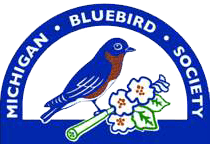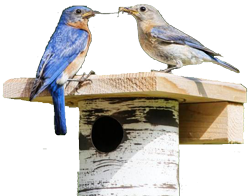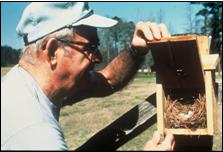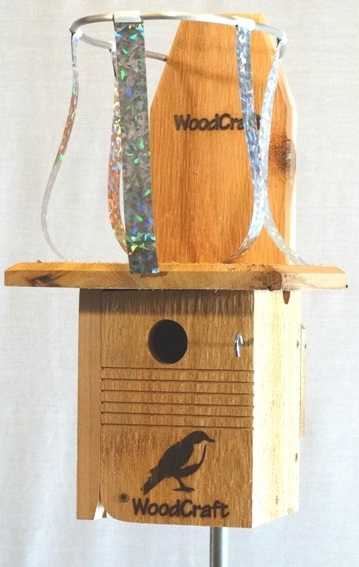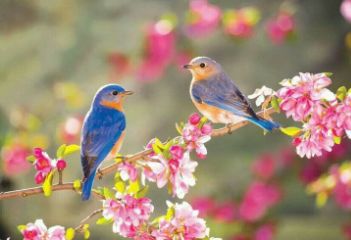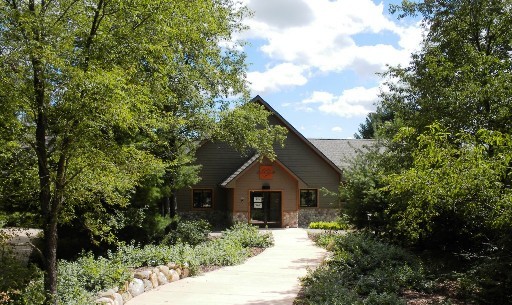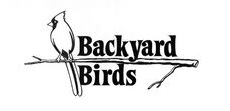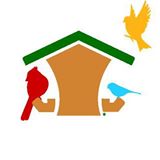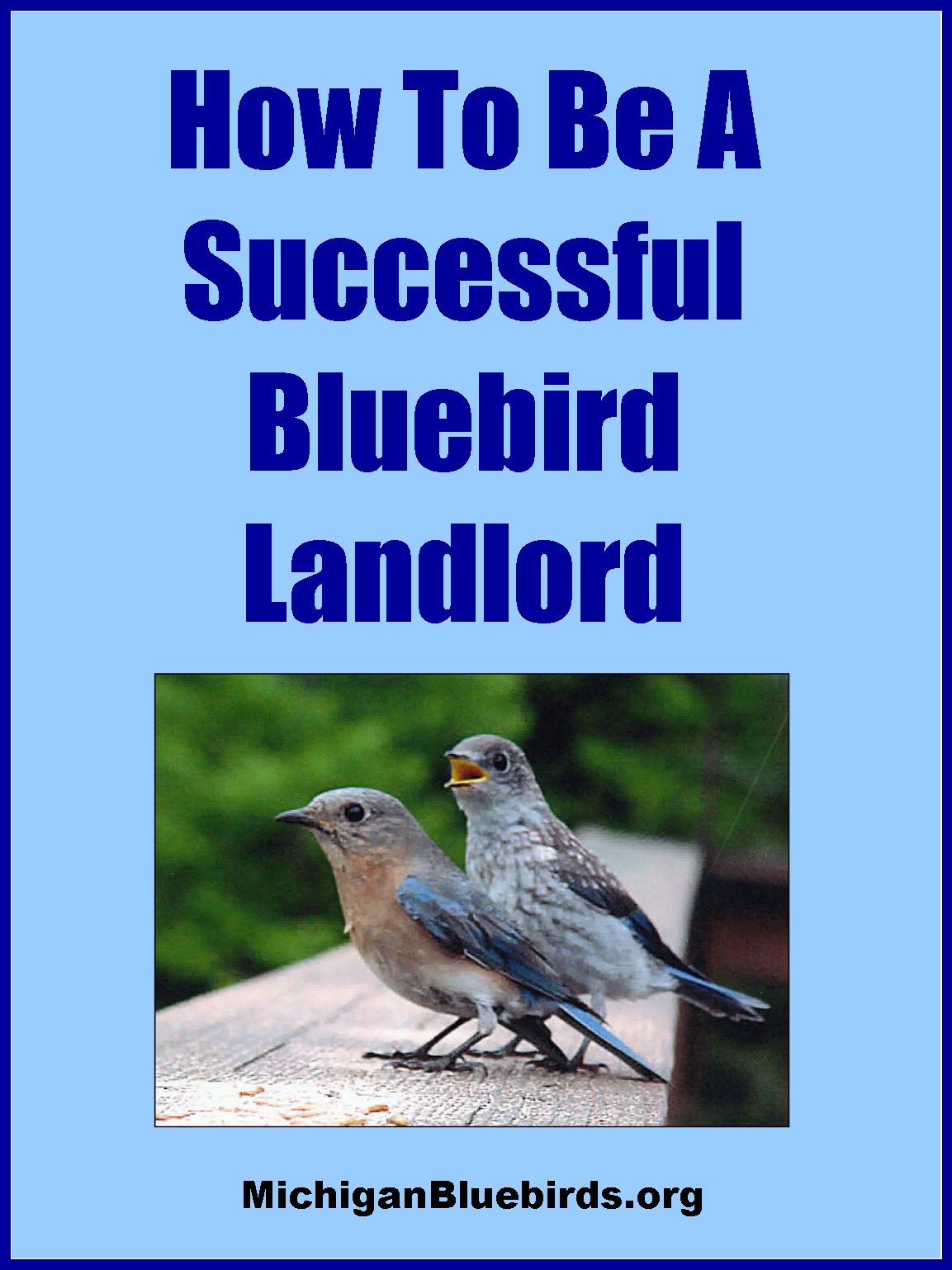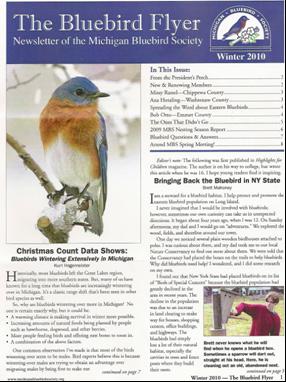How To Solve Problems That Come Up....
A number of challenging issues can come up in trying to have successful bluebird nests. This is why it is critically important to monitor your nest boxes regularly so you know that problems exist and then can take steps to resolve them. Below is a list of the main challenges and what you can do to prevent or solve the problems.....
House Sparrows - the #1 challenge to successfully fledging more bluebirds.
Insect Pests - insects or arthropods that infest the nest.
Nest Box Competitors - birds or mammals that may nest in the box too.
Predation - birds or animals that prey on the bluebirds or their eggs.
Poor Weather - a common occurrence in spring.
House Sparrows
Of all the problems faced by bluebird landlords, house sparrows are easily the worst. 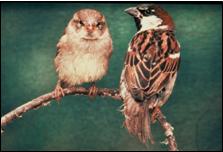 House Sparrows (HOSP's) are an overly aggressive, alien species of bird that prefers similar habitats and nesting locations as bluebirds. The male sparrow is particularly nasty and will often kill not just the young bluebirds but even the adults and eggs too. House Sparrows MUST be controlled in the habitat your nest boxes are placed in to ensure the nesting success of bluebirds.
House Sparrows (HOSP's) are an overly aggressive, alien species of bird that prefers similar habitats and nesting locations as bluebirds. The male sparrow is particularly nasty and will often kill not just the young bluebirds but even the adults and eggs too. House Sparrows MUST be controlled in the habitat your nest boxes are placed in to ensure the nesting success of bluebirds.
The Michigan Bluebird Society is providing this information on House Sparrow control to let you know that there are options available when dealing with sparrow problems. Given the widespread problems caused by House Sparrows, MBS advises that it is the responsibility of every nest box trail operator to ensure that no House Sparrows fledge from their boxes. It is better to have no nest box than to have one which fledges sparrows.
NOTE: House Sparrows are a non-native, alien species of bird that is NOT protected by any Federal or State laws. Therefore, it is 100% legal to trap these birds in your yard without a permit, if you prefer this option.
About House Sparrows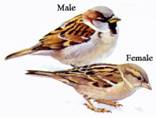
House Sparrows are the among the most abundant birds in North America and the most widely distributed birds on the planet. House Sparrows are not actually sparrows, but are Old World Weaver Finches, a family of birds noted for their ingenious nest-building abilities.
History
House Sparrows were introduced into North America from England in the 1850s on the mistaken premise that they would help reduce crop insect pests. At first, the new immigrants welcomed this little bird of their homeland. Within 25 years, however, they realized the seriousness of their mistake: the House Sparrow population had increased at an explosive and alarming rate, and the birds were causing extensive damage to crops and fruit trees. They were also taking over the nesting sites of native cavity-nesting birds.
Life and Habits
The breeding season for House Sparrows begins early in the spring or even in midwinter, and each pair may produce up to four broods a season. The male House Sparrow's bond with his nest site is stronger than his bond with a mate. In other words, he may lose a mate, but he won't give up his nest site. 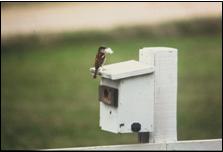 Although they usually prefer to nest in a cavity, House Sparrows will settle for any nook or cranny they can find. They will also occasionally nest in coniferous trees and in the nests of Cliff Swallows and Northern Orioles.
Although they usually prefer to nest in a cavity, House Sparrows will settle for any nook or cranny they can find. They will also occasionally nest in coniferous trees and in the nests of Cliff Swallows and Northern Orioles.
The male constructs a bulky, dome-shaped nest of coarse grasses, weeds, hair, junk, and feathers. The female lays three to five white/brown speckled eggs and incubates for 11-14 days. The young sparrows fledge after 14-16 days. They are not migratory, but flocks of birds move about within a 1.5-2mi. area. House Sparrows are primarily seed-eaters, although they eat some insects during the summer. They will also dine on garbage. Feedlots and farmsteads are particularly attractive to sparrows as they provide an abundant source of food, as well as shelter and plenty of nesting sites.
How To Control Sparrows
Control of sparrows in a yard or on a bluebird trail can be either PASSIVE (taking preventative measure when placing the box to deter sparrow use) or AGGRESSIVE (taking measures after the box is in place and sparrows are using it).
PASSIVE CONTROL
1. BOX LOCATION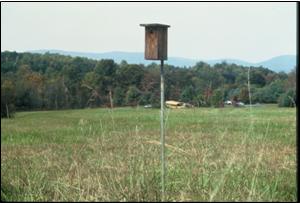 Box location is the most crucial factor in controlling sparrows on a bluebird trail. The House Sparrow's Latin name, Passer domesticus, aptly describes its preferred nesting habits - around houses. Avoid placing boxes near farmsteads, feedlots, barns, old out-buildings, etc. Boxes placed in or around villages, towns or cities will likely be claimed by House Sparrows. If sparrows do take up residence, one option is to relocate the box to a site farther away from human occupation. Being out in the open far away from dense cover or buildings of any kind is the best defense against sparrows.
Box location is the most crucial factor in controlling sparrows on a bluebird trail. The House Sparrow's Latin name, Passer domesticus, aptly describes its preferred nesting habits - around houses. Avoid placing boxes near farmsteads, feedlots, barns, old out-buildings, etc. Boxes placed in or around villages, towns or cities will likely be claimed by House Sparrows. If sparrows do take up residence, one option is to relocate the box to a site farther away from human occupation. Being out in the open far away from dense cover or buildings of any kind is the best defense against sparrows.
Sparrows may avoid a nesting site if the box is placed too low to the ground (3 to 5 feet). However, since boxes placed this low run the risk of being predated by raccoons, cats, or other climbing predators this is a feasible option where there are no climbing predators.
2. PLUGGING THE ENTRANCE HOLE
Plugging the entrance hole of a box taken over by sparrows will prevent the male from using that specific box, and might even encourage him to move elsewhere. Some bluebird trail operators plug the entrance hole at the end of the nesting season and leave it plugged until the bluebirds arrive in the spring. This will prevent sparrows from roosting in the box during the winter, and then staking an early claim in the spring.
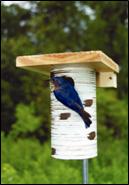 3. USE OF GILBERTSON PVC BOXES
3. USE OF GILBERTSON PVC BOXES
Although Gilbertson PVC boxes are not 100% sparrow resistant, House Sparrows seem to be reluctant to use them. It is thought that the shallow depth of the box, combined with the plastic wall material is not like by sparrows. If PVC boxes are paired with a wooden box, sparrows tend to choose the wooden box. If you are trying to attract bluebirds in an area where you suspect sparrow problems, it might be wise to start off with the PVC box.
4. ELIMINATING FEEDING AREAS, ROOSTING AND NESTING SITES
Problems with sparrows can be reduced if the overall, local House Sparrow population can be reduced. This can be achieved by taking control measures at bird feeding stations (use of sparrow-proof feeders; avoiding cheap, mixed bird seed that contains a high percentage of filler grains, such as milo, millet or cracked corn; or use of monofilament line around seed feeders), as well as sealing up all potential winter roosting and summer nesting sites. Look for potential gaps, large crevices, ledges, and openings in any sheds or outbuildings on your property and plug them up.
5. CLEANING OUT THE SPARROW NEST
The sparrows will build the nest each day and you will need to remove it from the box each time. 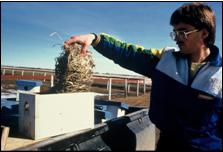 Keep doing this as long as it takes for the sparrow to either give up or run out of time to build a viable nest. Note that a sparrow nest will typically fill up the entire box and is very messy compared with a bluebird nest or most any other native species of bird. It often contains mixtures of materials including plastic and garbage. They can often rebuild a nest within a day, so persistence is required.
Keep doing this as long as it takes for the sparrow to either give up or run out of time to build a viable nest. Note that a sparrow nest will typically fill up the entire box and is very messy compared with a bluebird nest or most any other native species of bird. It often contains mixtures of materials including plastic and garbage. They can often rebuild a nest within a day, so persistence is required.
6. LEAVE THE SIDE/FRONT OF THE BOX OPEN
If sparrows are persistent and removing the nest isn't doing any good, try leaving the side panel (or front if the box front opens) open for several days. Sparrows will not build a nest in a space that is wide open, so this may cause them to go away so that the bluebirds can move in.
7. SPARROW SHIELD
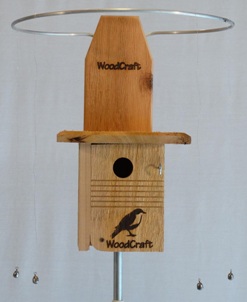
8. SPARROW CHASER
Another device that is similar to the Sparrow Shield is the Sparrow Chaser. It is based on a similar product generically called the Sparrow Spooker. However, the Chaser is designed to protect an active bluebird or swallow nest (one with eggs or young) from sparrow incursions. Like the Shield, it has a metal ring suspended above the nesting box with a wood bracket that attaches to the back. Hanging from the ring are a group of mylar strips that almost reach the rooftop and blow in the wind. The house sparrows dislike this because it scares them a little and keeps them from perching on the roof. The key is to install the Chaser ONLY after the bluebirds have built a nest and have either eggs or young in the box. Otherwise, it might spook them away from the box too.
AGGRESSIVE CONTROL
1. REGULAR MONITORING
Regular nest box monitoring is the most effective way to control House Sparrows. If sparrow nests are regularly removed, no young will fledge from the box. However, the male will tenaciously defend his box, and will usually keep rebuilding his nest. He will also drive off any other bird that might show an interest in the box. Therefore, it is important to eliminate the male. This is usually accomplished using an in-box trap.
2. IN-BOX TRAPPING
Two traps that work well are the basic Universal In-Box Trap and the Gilbertson House In-Box Trap.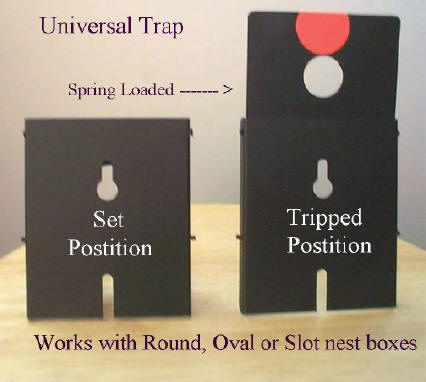
Do not set a in-box trap until a sparrow has laid claim to that box. Once he has claimed it, he will not allow any other species inside. The male sparrow will be more likely to enter the box if a small amount of nesting material is left in the bottom or tucked in the entrance hole. However, be careful that the nesting material does not interfere with the trap. The trap must be checked at least every two hours because there is the remote possibility that a bluebird or other native cavity-nester may have entered the box.
If a sparrow is trapped in the box, you must use a lot of caution in trying to get it out of the box. They are very adept at slipping through the smallest openings.
To remove a trapped House Sparrow from a box, place a clear garbage bag over the entire box being careful to cinch the bag around the pole so there are no gaps for the sparrow to slip through. Slowly open the box up. The sparrow should fly out and get trapped by the plastic bag. Isolate the sparrow in a part of the bag by holding onto it. Then, take the entire bag off the box with the sparrow inside it. This is a much easier method than trying to reach into the box and catch the sparrow by hand.
NOTE: House Sparrows are very wary by nature and will sometimes be hesitant to go into a box after a trap is installed. But, be persistent. Eventually, they will overcome this wariness and enter the box. Trial and error is often required to entice the sparrow into the box.
Since House Sparrows are classified as pests and are not protected by federal law, they should be quickly and humanely euthanized as soon as they are captured. Do not consider relocating the bird, as this just relocates the problem. The dead sparrows can be frozen and given to raptor recovery centers to feed their injured raptors.
3. MULTI-BIRD TRAPPING
There are several ways to trap a large number of birds:
A. Ground Traps: These traps are easy to construct, and can hold a large number of birds. Approximately 10 birds should be kept in the cage trap at all times to act as decoys. These decoys can be attracted into the trap by baiting them with white feathers, grain, bread scraps, white proso millet, mixed bird seed or cracked corn in it. A small mirror placed in the bait compartment of the trap helps to lure the sparrow in. Food, water, and shelter must be provided at all times. Since sparrows are gregarious, the success of cage traps depends on the birds being attracted to the food and to each other. For this reason, the trap works least effectively in areas with a high initial population. Used continuously once the population is under control, its effectiveness, though varied throughout the course of the year, is usually consistent. These traps are especially effective during the winter, and when juvenile birds are abundant in mid summer.
B. Cage Traps: Basically, these consist of nest boxes atop a wire cage. The nest box has as hinged floor, which tips the bird down into the cage below.
C. Drop traps, which simply drop down over a flock of feeding sparrows, can also be used once the sparrows are coming into an area regularly to feed.
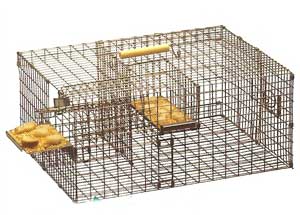 D. Self-Resetting or Repeating Live Trap. This is a repeatable trap that has a small "catcher" area that opens through a one-way trap door to a large holding pen. This permits the capture of a large number of birds. Like the ground trap, it works better if you keep one or two live birds in the trap to entice other sparrows inside. You can purchase this trap at sparrowtraps.net
D. Self-Resetting or Repeating Live Trap. This is a repeatable trap that has a small "catcher" area that opens through a one-way trap door to a large holding pen. This permits the capture of a large number of birds. Like the ground trap, it works better if you keep one or two live birds in the trap to entice other sparrows inside. You can purchase this trap at sparrowtraps.net
----------------------------------------
** IMPORTANT ** ALL traps can catch bluebirds and other native birds as easily as sparrows. Therefore it is critically important to always monitor traps and NEVER leave them unattended for long periods of time. Catching a native species of bird may cause undue harm or stress to them if left in a trap too long.
---------------------------------------
Insect Pests
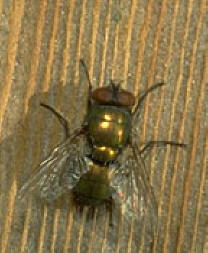 1. Blowflies - blowfly infestations can occur in any nestbox and is somewhat unpredictable. It's really the blowfly larvae that are the problem. The adults lay the eggs in the nest, which then hatch into larvae which feed off the blood of young birds. They reside underneath the nest during the day, and then crawl upward to attach themselves to the young birds in the evening. If an infestation is bad enough, it can severely deplete the young birds of blood, and may even cause death. Blowfly infestations seem to be more common in wetter nests combined with hotter weather.
1. Blowflies - blowfly infestations can occur in any nestbox and is somewhat unpredictable. It's really the blowfly larvae that are the problem. The adults lay the eggs in the nest, which then hatch into larvae which feed off the blood of young birds. They reside underneath the nest during the day, and then crawl upward to attach themselves to the young birds in the evening. If an infestation is bad enough, it can severely deplete the young birds of blood, and may even cause death. Blowfly infestations seem to be more common in wetter nests combined with hotter weather.
When monitoring boxes, make sure to look under the nests, especially after the young have hatched. The best way to solve blowfly problems is to remove the larva from the nest. This can be done by lifting up the nest and sweeping them out of the box. Also, you may need to gently shake the nest to remove more larva which may be caught in the nesting material. You may also need to actually remove them from the young directly. The larva will usually come off easily with minimal pulling.
If the infestation is bad enough, you may need to actually replace the nest. This can be done by gently putting the young in a holding tray, while taking out the old nest. Then, just fashion a round nest from dry grasses and put it in the box. Don't worry about making it perfect - the female will fix it to her liking upon returning to the box. Then, return the nestlings to the box. Make sure to dispose of the old nest well away from the nestbox so that it doesn't attract predators.
2. Buffalo Gnats - these are basically another name for black flies, of which there are around 30 separate species.  They can be a very serious risk for young birds because of their ability to bite. Their razor-like mouth parts are used to slash the skin and feed on blood. If young birds are bitten enough, it can cause death - either from blood loss, suffocation, toxemia caused by the bites, or anaphylactic shock. Bluebirders in several states, most notably Wisconsin, Minnesota, and Michigan have reported significant losses of baby birds due to these gnats.
They can be a very serious risk for young birds because of their ability to bite. Their razor-like mouth parts are used to slash the skin and feed on blood. If young birds are bitten enough, it can cause death - either from blood loss, suffocation, toxemia caused by the bites, or anaphylactic shock. Bluebirders in several states, most notably Wisconsin, Minnesota, and Michigan have reported significant losses of baby birds due to these gnats.
The gnats breed in rivers and streams, but can travel miles from these areas as adults. They live for about 3 weeks, but can be a problem for much of the later spring and summer months. It's possible that certain environmental conditions can contribute to them being worse in certain years than others. They are most active several hours after sunrise and several hours after sunset.
Because it's often difficult to tell whether they're around nest boxes, prevention is the best option. The gnats are attracted to the carbon dioxide in the breath of warm-blooded animals as well as dark colors. So, prevention methods are mainly important after the young have hatched and before fledging. Here are some steps that can greatly reduce or prevent loss of young birds to Buffalo Gnats:
- * Plug up ventilation gaps at the top of the box with screening to prevent flies from entering.
- * Apply pure vanilla extract (not synthetic or imitation) to the box outside around the entrance hole and ventilation gaps twice a week.
- * Spray pyrethrin (a natural insecticide) based product like Flys Away II or Flys X on the outside of the box. Spray the inside of the box front and walls if the exterior treatment does not work well. Do NOT get it on the baby birds directly. Cover them up if necessary while treating the box.
- * Consider painting the outside of the box white.
3. Ants - ants will sometimes infest bluebird boxes. In this part of the country, they don't usually result in deaths of the young birds, but it is still possible. The risk is usually the highest after the young hatch. You can eliminate this problem by either coating the bottom of the pole with Tanglefoot or Vaseline, or a safe insecticide like pyrethrin. You need to reapply these treatments after awhile though, as they will wear off after a time.
4. Mites - feather mites are not usually fatal to the birds, but can be an irritant to them. Usually, there isn't much you can do until the birds leave the nest. Then, remove the old nest and wash out the interior of the nest box with a 10% bleach/water solution. Rinse it out thoroughly and let it dry before remounting the nest box. Don't worry about getting them on your hands, as feather mites are completely harmless to people.
5. Wasps - certain species of wasps like to attach their paper nests to the sheltered, horizontal surfaces of bluebird nest boxes. 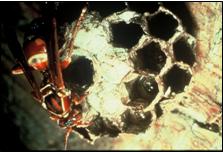 The underside of the roof is the most common spot. Wasps will force bluebirds to abandon the nest box, so it is wise to prevent them from building a nest. You can always just remove the nests, but they may rebuild it later. The best preventative step is to coat the underside of the roof with Ivory bar soap. This prevents the wasp's paper nest from sticking to the wood.
The underside of the roof is the most common spot. Wasps will force bluebirds to abandon the nest box, so it is wise to prevent them from building a nest. You can always just remove the nests, but they may rebuild it later. The best preventative step is to coat the underside of the roof with Ivory bar soap. This prevents the wasp's paper nest from sticking to the wood.
Nest Box Competitors
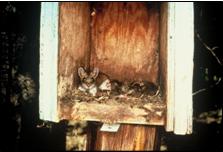 1. Mice - mice can sometimes infest nest boxes left out in the winter. If mice have nested in a box, you need to remove the nest carefully. Deer mice and some other species are known to carry a disease called hantavirus. Hantavirus can be fatal to humans, so it is VERY important to take precautions when getting mice out of box. Always wear rubber gloves and a breathing mask. Second, use a 10% bleach/water solution to soak the nest prior to removing it. Use a spray bottle and let the solution soak in for about 15 minutes before removal. Then, sweep out the inside of the box, spray it again, flip up the side/front of the box, and let it sit open for several days to dry out.
1. Mice - mice can sometimes infest nest boxes left out in the winter. If mice have nested in a box, you need to remove the nest carefully. Deer mice and some other species are known to carry a disease called hantavirus. Hantavirus can be fatal to humans, so it is VERY important to take precautions when getting mice out of box. Always wear rubber gloves and a breathing mask. Second, use a 10% bleach/water solution to soak the nest prior to removing it. Use a spray bottle and let the solution soak in for about 15 minutes before removal. Then, sweep out the inside of the box, spray it again, flip up the side/front of the box, and let it sit open for several days to dry out.
Boxes which get infested by mice are usually ones adjacent to fields or on fence posts. If the same boxes keep getting invaded by mice, open up the boxes all winter (since the mice won't nest in an open box) or just bring the box inside the garage for the winter.
2. House Wrens - MBS is including this section under Problem Solving so people who want to attract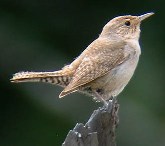 bluebirds are aware of the risks of having nesting House Wrens in the same vicinity. House Wrens are documented destroyers of eggs and even hatchlings of many other nesting bird species - including bluebirds. Bluebirders will often find eggs below the box that have been pierced and sometimes even young birds either missing or on the ground dead. And these are often boxes protected against climbing predators with baffles.
bluebirds are aware of the risks of having nesting House Wrens in the same vicinity. House Wrens are documented destroyers of eggs and even hatchlings of many other nesting bird species - including bluebirds. Bluebirders will often find eggs below the box that have been pierced and sometimes even young birds either missing or on the ground dead. And these are often boxes protected against climbing predators with baffles.
House wrens are a native cavity nesting bird that prefers brushy, dense-cover filled habitats. They are widespread throughout North America and are becoming more common in many areas. They build nests in cavities (like nesting boxes) made almost completely of sticks. The cavity is typically filled to the top. The male will often build multiple "dummy" nests in a yard and allow the female to select one. Active wren nests will have a feather or spider web lined area near the lower back part of the nest, and may include 6-8 brown speckled eggs or more.
The big problem is that House Wrens are usually (not always) not tolerant of other bird species nesting nearby. This is what is believed to cause them to destroy the eggs and young of other nearby birds - even ones that don't nest in tree cavities. Therefore, if you want to attract bluebirds to nest, it is advisable that you take some or all of the following steps to avoid the loss of eggs and young birds to wren attacks:
(NOTE: House Wrens are native birds and are therefore protected by Federal and State laws under the Migratory Bird Act. Trapping, hunting, or the destruction of active nests is not permitted)
- Place all bluebird boxes at least 200-300 feet away from dense cover, and shrubbery.
- Place bluebird boxes away from deciduous trees and closer to pines and evergreens, or simply way out in the open.
- Avoid nesting box types with larger openings like the slot design. This allows the wren to more easily enter the box with large sticks.
- Remove all dummy wren nests from your bluebird boxes. (Again, dummy nests will have no eggs, young, or lined portion of the nest near the bottom)
- Do NOT put out hanging or tree mounted wren nesting boxes in your yard.
- Consider putting a wren guard on your bluebird boxes ONLY AFTER the first egg has been laid. For details on how to do this, see Wren Guards at www.sialis.org.
3. Other Cavity Nesting Birds (other than wrens) - Please go to our page Other Cavity Nesting Birds for a description of each species you are likely to have nest in a bluebird box.
Predation
NOTE: You MUST monitor your nest boxes in order to become aware of whether your boxes are vulnerable to predators. Below is a summary of the major types of predators that can attack nesting boxes to go after adults, young, or eggs.
1. Hawks - Cooper's Hawks, and Sharp-Shinned hawks are two common predators of smaller birds. Coopers are especially common in open country and wide open habitats. It's basically impossible to prevent this type of predation. It's natural and will occur on occasion. But, compared to the other types of predation, you shouldn't lose much sleep over it.
2. Cats - feral or house cats that are left outside are a MAJOR threat to not only your bluebirds, but all nesting birds.  Domesticated cats are NOT natural predators and do not belong in the natural habitat despite what their owners may believe. It has been proven through research that outdoor cats kill millions of native birds every year. As far as bluebird boxes go, cats usually lurk nearby and leap up at the box when birds are leaving or entering.
Domesticated cats are NOT natural predators and do not belong in the natural habitat despite what their owners may believe. It has been proven through research that outdoor cats kill millions of native birds every year. As far as bluebird boxes go, cats usually lurk nearby and leap up at the box when birds are leaving or entering.
First, if you own a cat, keep him or her indoors at least during nesting season. If your neighbors have cats that wander into your yard all the time, try speaking with them about keeping their cats inside. Otherwise, the best strategy is to place you bluebird nesting boxes as far out in the open as you can away from high grass, weeds, or other cover. Cats don't like to be out in the middle of the yard in an unprotected area. They use stealth to approach their prey. So, making this very difficult will really help. Last, sometimes you can affix wide baffles to the pole to prevent cats from easily jumping up to the nest box. It would need to be at least 3 feet in diameter to do any good however.
3. Squirrels/Chipmunks - small mammals like squirrels and chipmunks are nest robbers that will sometimes steal eggs from boxes.  They will also sometimes take over nesting boxes to live in. Flying squirrels are especially likely to do this. The main solutions are to A) put your nest box out in the open away from woods and trees, and B) put a climbing guard or baffle on the pole to prevent mammals from climbing them. Cylindrical metal baffles are best placed about 4 feet off the ground. Any lower than this and squirrels can often jump above them.
They will also sometimes take over nesting boxes to live in. Flying squirrels are especially likely to do this. The main solutions are to A) put your nest box out in the open away from woods and trees, and B) put a climbing guard or baffle on the pole to prevent mammals from climbing them. Cylindrical metal baffles are best placed about 4 feet off the ground. Any lower than this and squirrels can often jump above them.
4. Snakes - there are several species of snakes in Michigan large enough to eat birds and their eggs. Rat or bull snakes are two of them. The good news is that they're not terribly common, so this type of predation is not your biggest worry. Snakes are a much larger problem in the southern U.S. Again, the best defense is a predator guard with a solid top so the snakes can climb the pole. Also, snakes don't like to move across open stretches of lawn. So, this is another good reason to locate your nest boxes away from thick brush, weeds, and high grass where snakes are more likely to be.
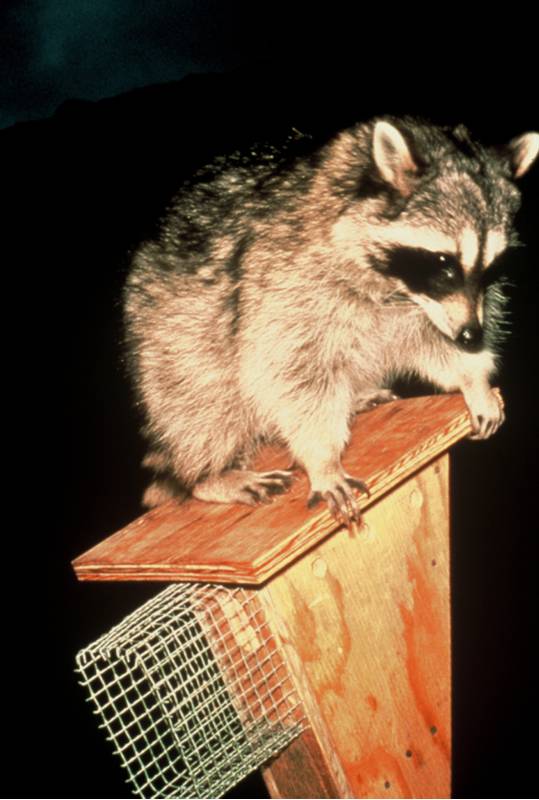 5. Raccoons - these climbing mammals are one of the biggest predators you need to be concerned with. They can't jump, but are adept climbers. They can shimmy up most round metal or wooden poles. Because raccoons are nocturnal, most bluebird landlords are not aware of their presence. The main evidence that they've found a nest, is that the nest has been disturbed and partially torn apart, with dirty foot marks on the pole. Often, broken egg pieces are found under the pole. Raccoons will keep coming back to a nest box once they've found food there once. So, this is yet another critical reason why you need to monitor your bluebird housing regularly. This is the only way you'll know there's a raccoon problem and enable you to prevent it from happening in the future.
5. Raccoons - these climbing mammals are one of the biggest predators you need to be concerned with. They can't jump, but are adept climbers. They can shimmy up most round metal or wooden poles. Because raccoons are nocturnal, most bluebird landlords are not aware of their presence. The main evidence that they've found a nest, is that the nest has been disturbed and partially torn apart, with dirty foot marks on the pole. Often, broken egg pieces are found under the pole. Raccoons will keep coming back to a nest box once they've found food there once. So, this is yet another critical reason why you need to monitor your bluebird housing regularly. This is the only way you'll know there's a raccoon problem and enable you to prevent it from happening in the future.
There are several possible solutions. First, put a metal raccoon baffle on the pole to prevent them from climbing the pole. This is the most effective way. The baffle should be a cylinder at least 24" high. You can either buy them at birdfeeding supply stores or make your own from stove pipe material at the home center. Second, you can "grease" the pole with a non toxic lubricant to prevent raccoons from climbing it. This can work for the short term, but will wear off over time. 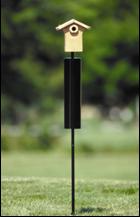 Third, you can put a guard over the entrance hole of the nest box to prevent raccoons from reaching into the interior of the box. This basically increases the reach distance into the box so far, that the raccoon can't reach the nest. These can work, but you should not put them on the box until the bluebird has started laying eggs. Otherwise, they may be scared off from the box.
Third, you can put a guard over the entrance hole of the nest box to prevent raccoons from reaching into the interior of the box. This basically increases the reach distance into the box so far, that the raccoon can't reach the nest. These can work, but you should not put them on the box until the bluebird has started laying eggs. Otherwise, they may be scared off from the box.
Here is an informative article for a simple and inexpensive metal stovepipe baffle you can make for around $12 to $15 from material at a home center. It has complete instructions and list of material.
Cowbirds - these native birds are actually nest parasites in that they lay their eggs in the nests of other species to get them to raise the cowbird chicks. 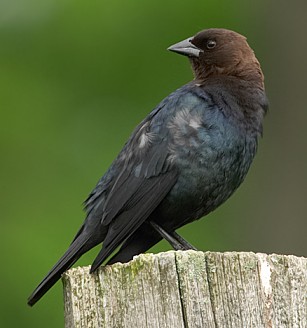 Typically, cowbirds lay one whitish/brown speckled egg in the other birds nest which usually hatches first. This is a problem because the cowbird chick is most often larger than the host bird young and will out-compete them for food from the parents. This can cause the nest to fledge less young. Cowbird eggs and bluebird eggs are about the same size.
Typically, cowbirds lay one whitish/brown speckled egg in the other birds nest which usually hatches first. This is a problem because the cowbird chick is most often larger than the host bird young and will out-compete them for food from the parents. This can cause the nest to fledge less young. Cowbird eggs and bluebird eggs are about the same size.
It is not common for cowbirds to lay eggs in bluebird nest boxes. However, it does happen. Sometimes, this may result in bluebirds abandoning the nest, but not always. Technically, being a native bird, cowbird eggs are protected by law once in the nest. However, some landlords will remove them. Check with the Michigan DNR for current policies regarding the removal of cowbird eggs.
For more information on predator control, Click Here to download the North American Bluebird Society's factsheet on Predator Control.
Poor Weather
Long cool stretches of wet weather are one of the major causes of nest failures. When these weather conditions persist for too long, bluebirds have difficulty finding food. This will eventually weaken the adults and prevent them from having the energy to feed hatched young. The result is that the bluebirds will stop feeding the young in order to save themselves.
The only thing you can do in this situation is to use supplemental feeding to give the bluebirds another source of food. Live meal worms can be offered in a separate feeder nearby. See the section on feeding meal worms or wax worms. Also, you can offer scrambled eggs too. Both foods should be fed in an open tray made of metal, glass, or plastic. This food may be the difference in their survival pending the return of warmer weather. For more information, see our page on Feeding Bluebirds.
